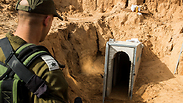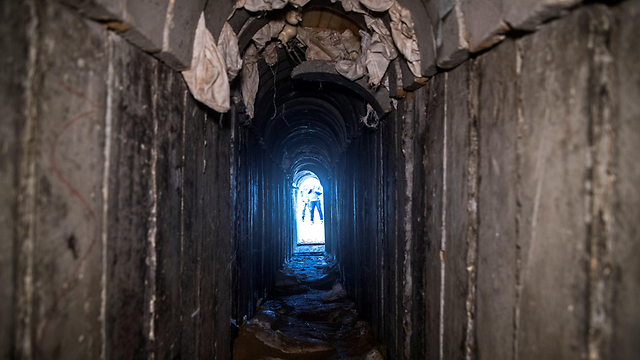

IDF: Hamas knows it lost the battle for the tunnels
Southern Command officer says the Gaza terror groups will likely redirect resources to other endeavors, such as rocket production or naval activity, after the offensive tunnel project has come to naught with Israeli underground border wall and detection technologies making tunnels less effective.
Israel has so far completed four kilometers of the 65 kilometer-long underground wall set to be built along the Gaza border to stop terror groups in the strip from digging tunnels into Israeli territory.
According to the IDF officer, hundreds of workers have already built the obstacle near the city of Sderot and the border-adjacent communities of Netiv HaAsara, Nahal Oz, Sufa, Holit and Kerem Shalom.
The obstacle project is set to be completed by mid-2019. But thanks to the recent technologies being developed in Israel, military officials estimated the IDF would be able to destroy all of Hamas's cross-border tunnels even before the completion of the underground wall, with more tunnels expected to be uncovered and demolished soon.
On October 30, 2017, the IDF blew up a tunnel reaching 200 meters into Israeli territory and some 2 kilometers away from Kibbutz Kissufim on the southern Gaza border. The explosion caused the death of 12 Palestinian Islamic Jihad terrorists.
That tunnel was being dug at the rate of 10-20 meters a day. At its deepest, the tunnel reached 26 meters below ground.
Inside, IDF soldiers found 1.5 kilometers of concrete slabs and arches, and even concrete floor at an area of the tunnel beginning in Khan Yunis and leading into Israel. The tunnel's height was about 1.80 meters, while its width was about 80 centimeters. It is big enough to allow a large force to move quickly through it, carry out an attack or a kidnapping, and escape back into the strip.
These developments have made the cross-border tunnels a costly endeavor, which requires a lot of resources and is likely not as effective as it once was. Regardless, Hamas is expected to continue building the defensive tunnels inside the Gaza Strip.
"Every day we can reach an escalation in Gaza," the Southern Command officer told military correspondents during a tour of the tunnel on the Gaza border on Thursday. "We're improving our preparedness, while Hamas watches in desperation as the millions it invested in iron and infrastructure for the tunnels come to naught."
The officer went on to explain that the main issue in the strip is the economic crisis, "which led Hamas to reconciliation with (PA President) Abbas. Gaza is at the worst condition it has been in over the last decade."
He added that the solution for Gaza "will not come from the American aid to UNRWA, but from international projects." He stressed, however, that Gaza's situation will not improve until the Israeli MIAs and POWs are held there by Hamas.

















